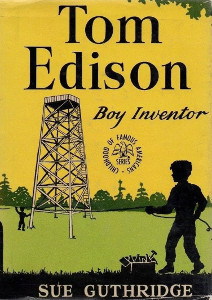Tom Edison: Boy Inventor

Author:
Sue Guthridge
Illustrator:
Betty Graham
Publication:
1947 by Bobbs-Merrill Company
Genre:
Biography, Non-fiction
Series:
Childhood of Famous Americans (Scientists and Inventors)
Series Number: 62
Pages:
200
Current state:
This book has been evaluated and information added. It has been read but content considerations may not be complete.
Book Guide
Search for this book used on:
It was easy to tell that young Tom Edison would make a name for himself. A lively boy who was always getting "ideas" about ways to make things more useful or interesting, he was curious about everything and wouldn't admit he could fail at anything. He had the real scientific approach to problems—even when he tried to help a goose hatch her eggs faster!
He never believed a fact until he saw it proved, and he was always willing to work patiently, to experiment again and again. He did not go to school, but by the time he was twelve years old he had taught himself more about chemistry and electricity than many grownups knew. And his childhood laboratories finally grew into the famous laboratories where he made the first practical incandescent light bulb.
Thomas Alva Edison is remembered as "the Wizard of Menlo Park," the great American who gave us such wonderful inventions as electric light bulbs, phonographs, motion pictures, and many, many other devices that have made life easier and happier and have changed the living habits of a whole nation. But when he was a boy, he would probably have said that the world's greatest invention was a railroad train!
Railroads were new, exciting and important in 1847, when Tom was born. If a railroad had been built through the little town in Ohio where the Edisons lived, their business would not have failed and they would never have had to move to Michigan. Tom would have continued to visit the shipyards and ask the friendly workmen question after question about boats and sailing.
If Tom hadn't had a long train trip to Michigan, riding up in the cab with the engineer, with his own hand on the throttle, he might not have been so fascinated by railroads. He might not have been so eager to take a full-time job, when he was only thirteen, selling newspapers, magazines and candy on the very first train that ran from his town to the city of Detroit.
Then Tom would never have had the first chemistry laboratory on wheels, in the baggage car of his train, or printed the first train newspaper, on his own little hand printing press. He would not have sold papers in the exciting days of the Civil War, when everyone wanted the latest news. He wouldn't have come so close to missing his train on one occasion that the conductor had to pull him aboard by his ears!
This entertaining story is a most readable introduction to the boy who became the wonderful inventor. Edison was one of the greatest Americans of our history. All his inventions were designed to make people more happy and comfortable, and more than any other one person he contributed to the enjoyment of life. Few subjects deserve better a place in the Childhood of Famous Americans Series.
Published just one hundred years after Tom Edison's birth, the story is a fine tribute, in terms children understand, to America's inventive genius. Sue Guthridge, who makes Tom such a likable boy, is a teacher in the Indianapolis schools. She has wisely selected just the episodes in his busy life to appeal particularly to young readers in a science-minded age, and has told them delightfully.
From the dust jacket
To view an example page please sign in.


